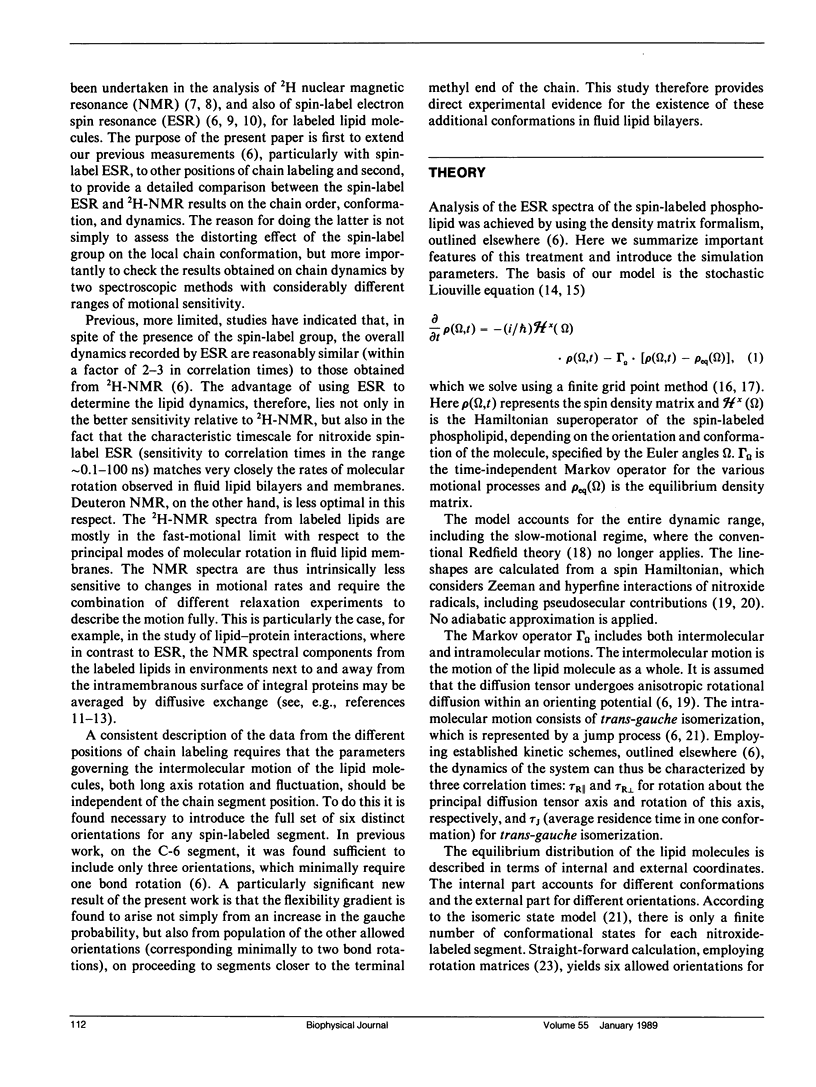Abstract
The electron spin resonance spectra of 1-myristoyl-2-[n-(4,4-dimethyloxazolidine-N-oxyl)myristoyl]-sn- glycero-3-phosphocholine spin-label positional isomers (n = 6, 10, and 13) have been studied in oriented, fully hydrated bilayers of dimyristoylphosphatidylcholine, as a function of temperature and magnetic field orientation. The spectra have been simulated using a line-shape model which incorporates chain rotational isomerism, as well as restricted anisotropic motion of the lipid molecules as a whole, and which is valid in all motional regimes of conventional spin-label electron spin resonance (ESR) spectroscopy. At least one component of the lipid motion is found to lie in the slow-motion regime for all label positions, even in the fluid liquid crystalline phase, well above the phase transition. In the gel phase, the chain isomerism lies in the slow-motional regime, and the overall motions are at the rigid-limit. In the fluid phase, the chain isomerism is in the fast-motional regime, and the chain axis motions are in the slow regime. This indicates that the commonly used motional-narrowing theory is not appropriate for the interpretation of spin-label spectra in biological membranes. The simulation parameters yield a consistent description for the chain order and dynamics for all label positions. The correlation times and order parameters for the overall motion are the same at all positions down the chain, whereas the chain conformation and trans-gauche isomerism rate display a characteristic flexibility gradient, with increasing motion towards the terminal methyl end of the chain. Significantly, it is found that all six distinct tetrahedral orientations of the hyperfine tensor at the labeled segment are required for a consistent description of the chain isomerism. For the C-6 segment only the 0 degree (trans) and two 60 degrees (gauche) orientations are significantly populated, for the C-10 position two further 60 degrees orientations are populated, and for the C-13 position all orientations have non-vanishing populations. Detailed comparisons have been made with the results of 2H nuclear magnetic resonance (NMR) measurements on dimyristoylphosphatidylcholine labeled at the same position in the sn-2 chain, and using an identical motional model. The parameters of overall reorientation, both order parameter and correlation times, have very similar values as determined by ESR and NMR. The major difference between the results from the two methods lies in the conformational populations at the labeled chain segment and the trans-gauche isomerization rate in the gel phase. The conformational order is much lower for the spin-labeled chain segments than for the corresponding deuterium-labeled segments, and the isomer interconversion rates in the gel phase(although displaying a mobility gradient in both cases) are found to be much slower in the former case. In addition the spin-label measurements provide information on the macro order (chain tilt), which is only available from oriented samples. These results are consistent between the different spin label positions and are in agreement with the findings from x-ray diffraction.
Full text
PDF












Selected References
These references are in PubMed. This may not be the complete list of references from this article.
- Dill K. A., Flory P. J. Interphases of chain molecules: Monolayers and lipid bilayer membranes. Proc Natl Acad Sci U S A. 1980 Jun;77(6):3115–3119. doi: 10.1073/pnas.77.6.3115. [DOI] [PMC free article] [PubMed] [Google Scholar]
- Finegold L., Singer M. A. The metastability of saturated phosphatidylcholines depends on the acyl chain length. Biochim Biophys Acta. 1986 Mar 13;855(3):417–420. doi: 10.1016/0005-2736(86)90086-6. [DOI] [PubMed] [Google Scholar]
- Hubbell W. L., McConnell H. M. Molecular motion in spin-labeled phospholipids and membranes. J Am Chem Soc. 1971 Jan 27;93(2):314–326. doi: 10.1021/ja00731a005. [DOI] [PubMed] [Google Scholar]
- Janiak M. J., Small D. M., Shipley G. G. Nature of the Thermal pretransition of synthetic phospholipids: dimyristolyl- and dipalmitoyllecithin. Biochemistry. 1976 Oct 19;15(21):4575–4580. doi: 10.1021/bi00666a005. [DOI] [PubMed] [Google Scholar]
- Kar L., Ney-Igner E., Freed J. H. Electron spin resonance and electron-spin-echo study of oriented multilayers of L alpha-dipalmitoylphosphatidylcholine water systems. Biophys J. 1985 Oct;48(4):569–595. doi: 10.1016/S0006-3495(85)83814-5. [DOI] [PMC free article] [PubMed] [Google Scholar]
- Lange A., Marsh D., Wassmer K. H., Meier P., Kothe G. Electron spin resonance study of phospholipid membranes employing a comprehensive line-shape model. Biochemistry. 1985 Jul 30;24(16):4383–4392. doi: 10.1021/bi00337a020. [DOI] [PubMed] [Google Scholar]
- Marcelja S. Chain ordering in liquid crystals. II. Structure of bilayer membranes. Biochim Biophys Acta. 1974 Oct 29;367(2):165–176. doi: 10.1016/0005-2736(74)90040-6. [DOI] [PubMed] [Google Scholar]
- Mason J. T., Broccoli A. V., Huang C. A method for the synthesis of isomerically pure saturated mixed-chain phosphatidylcholines. Anal Biochem. 1981 May 1;113(1):96–101. doi: 10.1016/0003-2697(81)90049-x. [DOI] [PubMed] [Google Scholar]
- Meier P., Blume A., Ohmes E., Neugebauer F. A., Kothe G. Structure and dynamics of phospholipid membranes: an electron spin resonance study employing biradical probes. Biochemistry. 1982 Feb 2;21(3):526–534. doi: 10.1021/bi00532a018. [DOI] [PubMed] [Google Scholar]
- Meraldi J. P., Schlitter J. A statistical mechanical treatment of fatty acyl chain order in phospholipid bilayers and correlation with experimental data. B. Dipalmitoyl-3-sn-phosphatidylcholine. Biochim Biophys Acta. 1981 Jul 20;645(2):193–210. doi: 10.1016/0005-2736(81)90190-5. [DOI] [PubMed] [Google Scholar]
- Schindler H., Seelig J. Deuterium order parameters in relation to thermodynamic properties of a phospholiped bilayer. A statistical mechanical interpretation. Biochemistry. 1975 Jun 3;14(11):2283–2287. doi: 10.1021/bi00682a001. [DOI] [PubMed] [Google Scholar]
- Seelig A., Seelig J. The dynamic structure of fatty acyl chains in a phospholipid bilayer measured by deuterium magnetic resonance. Biochemistry. 1974 Nov 5;13(23):4839–4845. doi: 10.1021/bi00720a024. [DOI] [PubMed] [Google Scholar]
- Taylor M. G., Smith I. C. The conformations of nitroxide-labelled fatty acid probes of membrane structure as studied by 2H-NMR. Biochim Biophys Acta. 1983 Sep 7;733(2):256–263. doi: 10.1016/0005-2736(83)90530-8. [DOI] [PubMed] [Google Scholar]


